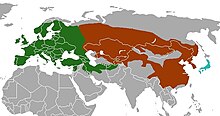Meles (genus)
|
Meles Temporal range: to present |
|
|---|---|
 |
|
| Meles meles, M. leucurus, and M. anakuma. | |
| Scientific classification | |
| Kingdom: | Animalia |
| Phylum: | Chordata |
| Class: | Mammalia |
| Order: | Carnivora |
| Family: | Mustelidae |
| Subfamily: | Melinae |
| Genus: |
Meles Brisson, 1762 |
| Species | |
 |
|
| Range map of the genus | |
Meles is a genus of badgers containing three living species, the Japanese badger (Meles anakuma), Asian badger (Meles leucurus), and European badger (Meles meles). In an older categorization, they were seen as a single species with three subspecies (Meles meles anakuma, Meles meles leucurus and Meles meles meles). There are also several extinct members of the genus.
The genus Meles was erected by French zoologist Mathurin Jacques Brisson in 1762 after Carl Linnaeus had described the Eurasian badger Meles meles in 1758. This animal had a very extensive range over most of temperate Europe and Asia and there has been much discussion as to whether it is a single species or three distinct species. There are geographical differences between individuals from different parts of the range in skull structure, morphology of the first premolar teeth, and facial markings. Some authorities advocated placing European and Asian badgers in separate species, Meles meles and Meles leptorhynchus (Milne-Edwards, 1867), the boundary between the two being the Volga River. Others considered there to be three subspecies, M. m. meles, found west of the Volga, M. m. arenarius-leptorhynchus, found between the Volga and Transbaikalia, and M. m. amurensis-anakuma from the Amur region and Primorskii.
Genetic studies of shows the separation of two variants on either side of the Volga but their exact taxonomic rank remains undefined. A further study of cheek teeth from individuals across the entire range supports this division and provides confirmation that M. meles and M. anakuma are indeed separate species.
European badgers (Meles meles) are powerfully built animals with small heads; thick, short necks; stocky, wedge-shaped bodies; short legs, and club-shaped tails. Their feet are digitigrade and short, with five toes on each foot. The limbs are short and massive, with naked lower surfaces on the feet. The claws are strong and elongated, and have an obtuse end for digging. They have flexible snouts and small eyes and ears. The coat is harsh on the back and sides with long bristly guard hairs and a sparse, short-haired underlayer. The belly is clothed in fine short hairs. The colour of the back and sides is light silvery-grey, with straw-coloured highlights on the sides. The tail has long and coarse hairs, and is generally the same colour as the back. Two black bands pass along the head, starting from the upper lip and passing upwards to the whole base of the ears. Other parts of the face are white. Size varies according to subspecies but is usually between 60 and 90 centimetres (24 and 35 in) in body length and 12 and 24 cm (5 and 9 in) in tail length. Adult males are generally heavier than females and can weigh between 15 and 17 kilograms (33 and 37 lb) in autumn when maximum fat reserves are present. European badgers are found across Europe and in parts of Asia west of the Volga River.
...
Wikipedia
